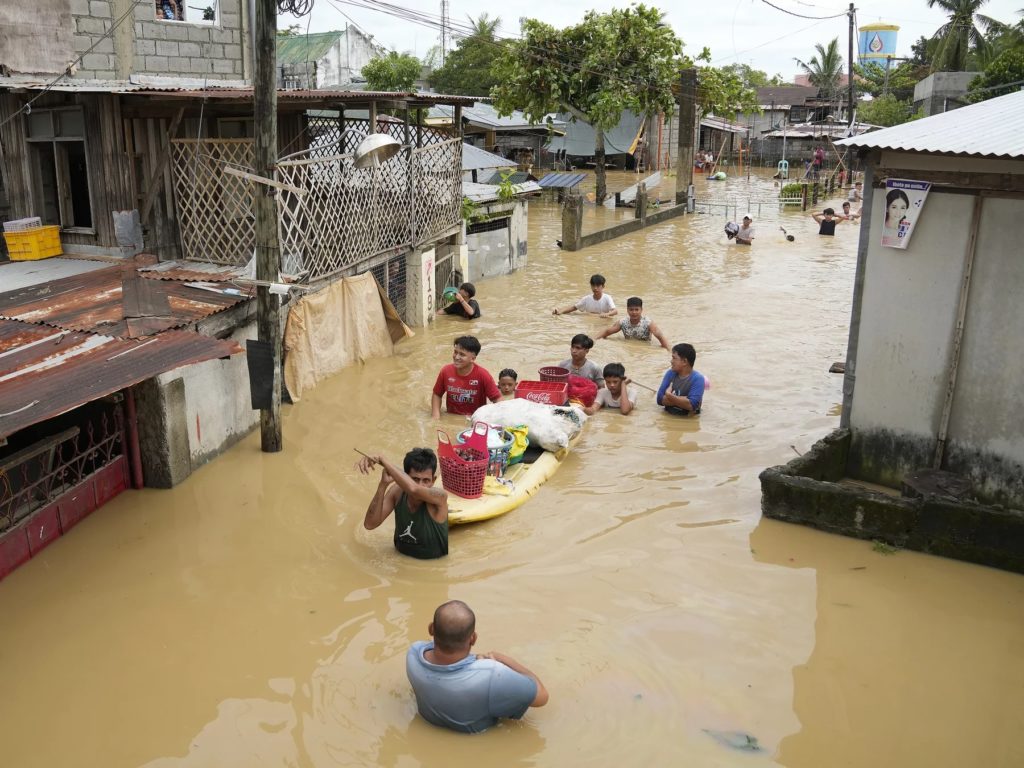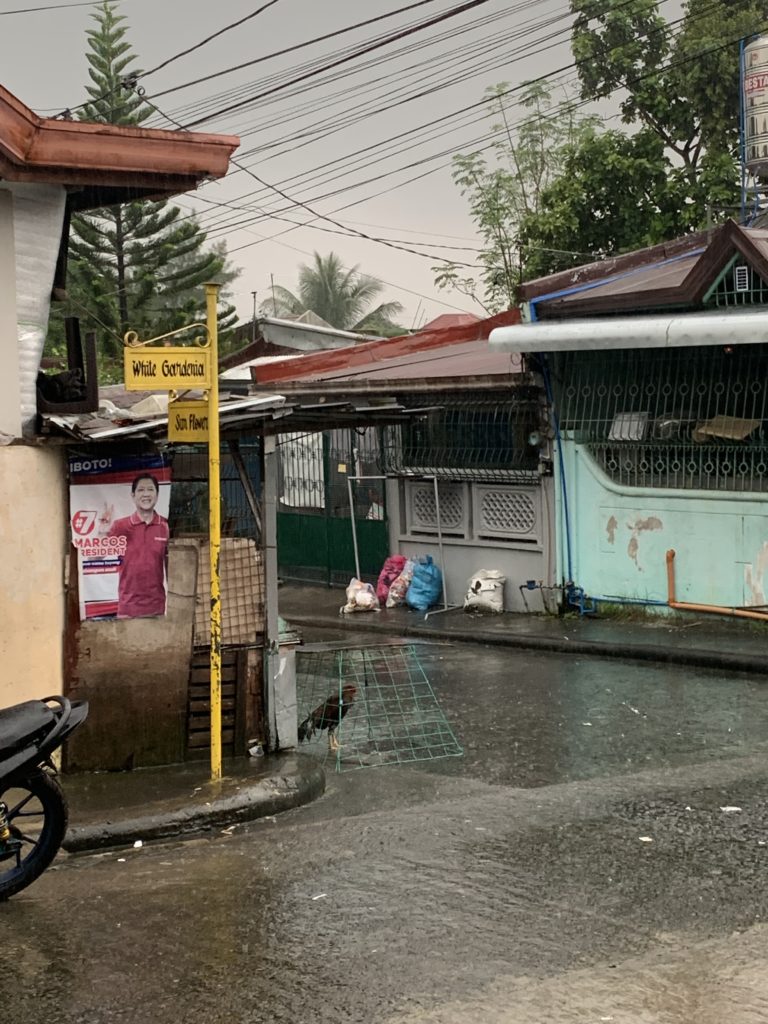I watched this week from The Philippines as untold many in Canada were wringing their hands over Hurricane Fiona’s errant trip north to Nova Scotia and Newfoundland. By then Fiona was ‘merely’ a tropical storm but severe indeed; many photos followed of damaged houses perched precariously over the rocky shores, their foundations gone and their fridges floating on the shore. Power lines were down and volunteer hydro crews from Maine were detained at the Canadian border without their ArriveCan apps completed. As far as I saw reported, there were no deaths.
Meanwhile, Super-Typhoon Karding was bearing down on the Pacific coast of Luzon, Philippines most populated north Island, with Signal 4 winds of 195-225 kph. Many thousands of Filiponos’ corrugated steel and cement block houses were mangled and many more flooded out. There were perhaps eight fatalities, five of whom were rescue workers who drowned in an errant rescue mission in a flooded plain of east Bulacan Province just north of Manila.

This was the 11th serious typhoon of the Philippines typhoon season this year; they can expect perhaps 9-14 more. Karding (called Noru Internationally) was the first Category 4 to cross the islands this year; the others petered out or veered north to smack Japan.
I’m not sure why I follow the deranged world of the twitterverse, and I suppose it says something about me that I do. (In fact I do know why I enrolled in twitter – I actually have two accounts – and it was originally to promote my books and myself. Hardly yielded any fruit yet but I’m told I need thousands and thousands of followers before I can expect any traction, not the 112 I have now. Still…)
Anyway, I observed in the running commentary on Fiona one wag dryly remarking, ‘how did hurricanes start before there were fossil fuels?’, to which another answered, the Sahara, which turns out to be an interesting thesis, but hardly explains the source of typhoons in The Philippines. (The answer by the way is that in summer in the tropical zones as the surface water heats to 26o C+ this begins a heat exchange process with the cooler atmosphere. Hot air rises, much like the twitterverse, or politics, and rotates in circles. This happens in both hemispheres, not just the superheated Centre of the Universe, Florida.)
Tag-ulan is the rainy season in The Philippines, lasting more or less from July to November. Tag-lamig is the ‘cool’ season running from December through to March; Tag-init is the hot season from April to June. To newly arrived visitors from temperate climates this distinction is highly academic: It’s pretty much always hot. In Tag-ulan it is noticeably more humid and, much like muggy July in Ontario, prone to afternoon thunderstorms. Tag-ulan is also called typhoon season in the Philippines, much as in India it’s called monsoon season. It rains every day. Mornings start off relatively clear, though muggy, beginning to cloud over by noon and then raining, often by 1:00, certain by 4:00.

All this rainy weather has pretty much kept me captive in Carmen’s tiny house, but I have been able to occupy myself with reading, writing my blogs, proof-reading my latest opus, My Story, Mostly, and attending to CAA business even though removed by twelve hours on the international clock (such are the wonders of modern communications afforded by the internet). But during lightning and thunder the caring Carmen obliges me to put away my i-Pad and i-Phone.
Occasionally – more than occasionally – the typhoon picks up speed and becomes a tropical cyclone, or as they call it in Pilipiñas, a Super Typhoon. Even that term is a matter of vernacular, since Typhoons (cyclones) of wind speed of 30-60 kph and 61-120 kph (Category 1 and 2 (labeled ‘Signal’ in the Philippines) types) are sufficiently commonplace as to warrant almost no attention. Signal 3 Typhoons are noteworthy and Category 4 and 5 Typhoons are justifiably referred to as Super Typhoons. (When I lived in The Philippines in 2019 I experienced two Signal 2 storms, and two Super Typhoons which were truly noteworthy!)
[One faithful blog reader of Travels With Myself, concerned for my well-being on the news of Noru bearing down on the Philippines, wondered if I was becoming a storm-chaser (and volcano observer) risking my own demise. I’m not as crazy as I was three years ago but I have made decisions that lead my life tempting fate. Did I mention there was also a tsunami warning on Friday last week due to seismic activity off the west coast of the Philippines. It never materialized and in any event Trece is sufficiently inland as to be out of reach of surf surge. Still, on the Wednesday two days prior, the family and I were enjoying a Cavite beach on the south shore of the vast Manila Bay, oblivious to possible threats.]
When Typhoon Karding hit us in Cavite Province on Saturday night it had been downgraded to Signal 2 from Signal 4. The weather service nevertheless sent out alert notices and the family spent the day charging their devices, filling water pails and locating candles and matches in anticipation of black outs. The wind howled all through the night and the rain was thunderous on the metal roof. Sleep was difficult but became quite impossible around 4:00 a.m. when the storm suddenly stopped. Amazing how the sentient mind becomes inured to stimulus and then only reawakens with change. There was turbulence all through Sunday and Monday but life had returned pretty much to normal: shopping at the malls.
Tuesday brought twelve hours of continuous thunderstorms. It was the tailwinds of Karding (now referred to again as Noru) as it passed out of The Philippines Sea and across the South China Sea on its way to Viet Nam. Not much moved all that day. I thought it inhumane that the neighbour across the street left their rooster out in the rain all day.

Rainy days severely limit commerce and economic activity in The Philippines. With Super Typhoons, everything comes to a halt, government and schools suspended. This is a chronic problem for the Philippines economy but acute for the millions of Filipinos who operate micro-enterprises, called tindahans, out of their tiny houses. In fact, for days on end, many of them don’t even open for business since there are no customers about.
Carmen has two tindahans – a sari-sari store (household items) in the front vestibule of her little house,

and an RTW (Ready-To-Wear) store in the front of daughter Olice’s house, shared with son GR’s barbero shop

In Tag-init and Tag-lamig Carmen hopes to see sales of 1000 peso/day at the sari-sari store and 2-3000 pesos/day at the RTW, but during tag-ulan sales are often only a couple hundred pesos, and in really bad stretches, zero. Christmas selling can realize 10 – 20k per day!
For a barely sufficient income, Carmen needs revenues of PhP 60,000/month and net perhaps 30,000/ month. At 2 or 3 k per day she’s okay; at 2 or 3 hundred per day, disaster.
Covid and post-Covid depression has made this a chronic problem. She hasn’t seen 2-3k per day for many months. And yet she still needs to support her extended family: son GR is doing moderately well but the depression holds back his expansion ambitions (he has three barber shops now and a burger stand; he and his wife Meilyn are supplementing their income raising their second litter of Miniature Poodles, imagine that); daughter Olice lost her call centre job in Manila which has now closed down entirely, her husband has an administrative job in Manila and supports his parents there; daughter Celca used to run a robust wholesale business shipping clothing to tindahans in the Visayas Provinces but that has ground to a halt. Hence the need for weekly and monthly allowance from Canada.
Now, Celca has found a new boyfriend who operates a gutohan restaurant in Rizal, a four-hour commute from Trece Martires, but has left her two kids to allow them to continue in their schools in Trece and be cared for by Carmen. Olice has accepted a call-centre job in Singapore and will be sending money home to Carmen who will now be caring for four apos for the foreseeable future.
When I return to Canada October 9 I feel as if I am abandoning Carmen to many months if not years of difficulty. But she is a strong woman and like so many Filipinas, accepts this as her duty.
All in all, life in The Philippines continues to be a struggle – especially in tag-ulan and typhoon season.
As the song goes, ‘into each life a little rain must fall’. But surely, enough is enough.
Doug Jordan,
Trece Martires, The Philippines
